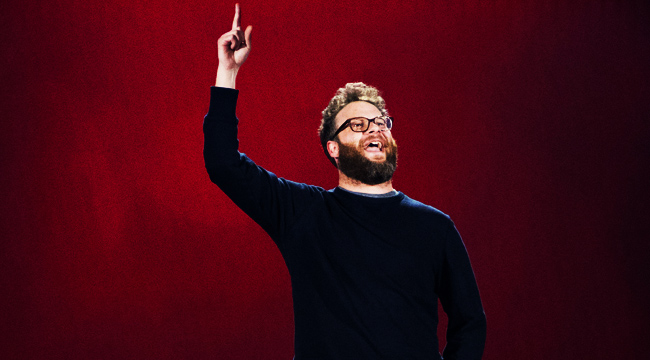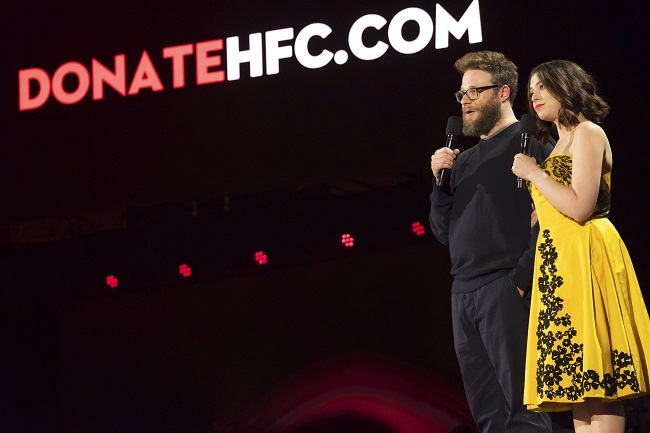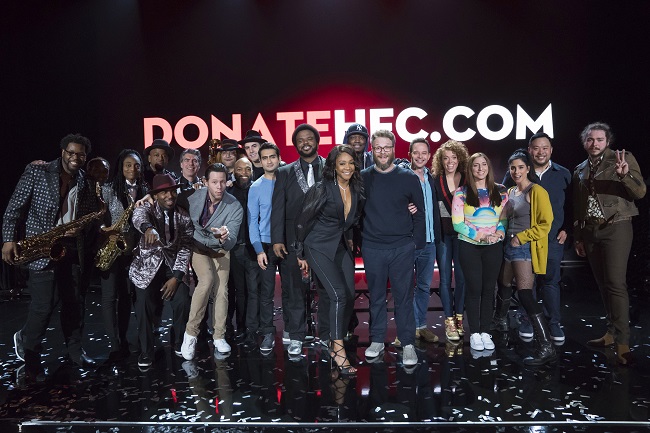
“We want this special to be seen as many people as possible,” Seth Rogen tells the crowd at the Hollywood Palladium, where his new Netflix variety special, Hilarity for Charity was filmed in late March. Best known for films like Knocked Up and Neighbors, the comedic actor and his wife, screenwriter and actress Lauren Miller Rogen, are the minds (and muscles) behind the “Hilarity for Charity” organization. Founded in 2012, the group has raised millions of dollars for Alzheimer’s disease research and at-home care for those affected by it with annual charity shows. Hence Rogen’s plea for getting as many people to see it as possible.
Said plea also serves as the basis for one of the special’s predominant themes: tricking the Netflix algorithm (delightfully portrayed by Jeff Goldblum) into slapping as many categories on it as possible. In the context of the show’s many sketches and stand-up performances, the gag pays off as it stays true to the “variety” of its format. Then again, previous “Hilarity for Charity” events have always stuck to particular themes, be it hosting a bar mitzvah for James Franco or throwing a prom with musical guests Bell Biv Devoe. As Rogen explains it, however, it was important to play to the audience at home this time around.
“For this year’s show theme, we decided to make things a little more clear,” Rogen tells us. “All we had to go on was they were going to be watching it on Netflix, so that seemed like a good place to start.” Yet there’s a lot more to Hilarity for Charity than simply cracking a bunch of jokes about the streaming giant’s hyper-focus on stand-up comedy, for as Rogen reveals later in our conversation with him, he and Lauren Miller’s annual charity falls in line with a long history of similar functions put on by comedians past and present. “I grew up watching Comic Relief,” he says of the American specials from the late ’80s and early ’90s starring Billy Crystal, Whoopi Goldberg, and the late Robin Williams. “It was a huge part of my childhood.”
What kinds of reactions have you seen to the taped Netflix special so far?
People seem into it. I don’t know. It seems like people like it. I mean, people online also love to say how much they hate things, but there haven’t been a lot of people telling me how much they hate this. So whenever that happens, I consider it to be something that’s very successful.
True, but considering the cause, I imagine a lot of it has been positive.
Very much so. It seems as though a lot of people are engaged. What’s so cool about it, to me, is that I’m getting a lot of messages from people that are like, “I’ve literally never donated to charity before, and after watching this, I feel inclined to donate.” And honestly, even if people don’t give a lot of money, it’s very meaningful to us that they’re engaged, and that they’re becoming a part of our efforts to try to solve these problems. To become a part of the conversation about Alzheimer’s disease, which they’re actually contributing to when they donate just a few bucks. Honestly, I’ve been amazed by how many people actually seem to be doing that.

This was the sixth Hilarity for Charity event you guys have hosted, but the first that’s been broadcast to the world. So I imagine those kinds of responses, and especially the donations themselves, have gone up significantly.
Yeah, for sure. I think there are thousands and thousands of more people now who know a lot more about Alzheimer’s disease than they did a week ago. They also definitely know now that I am an advocate for this cause in a way that they didn’t a week ago. I mean, I’ve just seen that from the messages I’ve been getting from all of these people. That’s as far as awareness goes, as well as messages from people who are going through the same kinds of things that Lauren has gone through.
It seems to be a very good mix of people who knew nothing about Alzheimer’s disease, and now know something about it, or people who thought they were completely alone in whatever their situation was who now understand that they’re not alone at all. And I hope that helps, that they know there are people like me and my wife who are going through the exact same thing they are.
A lot of the promotional material emphasizes raising awareness about Alzheimer’s disease among millennials and younger generations. Why is that?
Because they’re the ones who are ultimately going to solve this problem, I think. They’re the ones who will inherit all of the snowball effects of our generation having not solved it. It’s estimated that Alzheimer’s is the costliest disease in America right now, so that will have to be dealt with by somebody, at some point. More and more people are getting diagnosed with it, and I think more than ever that it’s the younger generations who are willing to do something about it. They’re the ones who can destigmatize it. They’re the ones who can make it a part of the cultural conversation. They’re the ones who can ultimately inspire and accomplish the changes that are necessary in order to cure it.
Previous shows have been themed. For example, a few years ago you threw James Franco a bar mitzvah. This year’s was all about Netflix. It makes sense, obviously, but did you have other ideas in mind before Netflix came onboard?
Yeah. I mean, they joined the conversation pretty early in the organizational process, and once they did, we kind of wanted to start things over a little bit. We wanted to approach it as if most of the people who would be seeing it on Netflix had never seen it before, which is true. Most of the viewers probably haven’t attended previous Hilarity for Charity events. The idea of doing a variation on the theme seemed a little confusing, maybe because there was no established theme to start with, if that makes sense.
In general, a lot of the same people have been coming here for years, so for this year’s show theme, we decided to make things a little more clear. Especially for the people who had never seen it before. We kind of wanted to start over. All we had to go on was they were going to be watching it on Netflix, so that seemed like a good place to start.
Putting together a live show is one thing, filming it for a later broadcast is another. What was different about doing Hilarity for Charity as a taped comedy special?
It was pretty weird, to be honest. I mean, we shot the show in a very weird way since we had all of these sketches that were performed in the moment, there in front of the audience. We decided not to do it all or mostly as pre-taped sketches, so the entire show was shot live in front of the people who were there. They were like miniatures, little dioramas. In my head, was trying to do something that was geared towards making a finished product, that had a good production values and felt kind of like a cinematic experience to those who’d be watching at home. But also something that was a little different, maybe texturally different, from what viewers are used to seeing. Like sketches that were performed in front of a live audience.
At the same time, I also wanted to consider the audience at home, and make it fun for them to see how it was all being put together. I wanted them to see how we were filming these things in an incredibly complicated way, even though they sometimes appear deceptively simple on screen. We also wanted to make it fun for people who were there in the room with us, because they were getting to see the crazy things we were going through in order to put all these elements together. I hope people think the finished product is fun to watch.

As someone who watched the special at home, that was one of the aspects I enjoyed the most — seeing the behind-the-scenes glimpses.
That’s what we were going for.
I wanted to ask you about the introduction you use for Tiffany Haddish, Michelle Wolf, and the rest of the comics…
[Laughs.] “They’ve been playing at clubs and colleges all across the country.”
What’s the story behind that?
I’m not a good stand-up comedian, so when I initially tried to come up with jokes to use while introducing the comics, a lot of them were these simple intros and they just weren’t working. It ended up being so lame that one of the show writers pitched the idea that I say the same thing for every single one of them. “They’ve been playing at clubs and colleges all across the country.” And it just seemed so silly and funny that we ran with it.
British and American comedy is rife with examples of performers and groups putting on regular charity shows. One example I immediately think of is Comic Relief, which started overseas and came to the U.S. in the ’80s. Is Hilarity for Charity an attempt to continue that tradition?
I grew up watching Comic Relief. It was a huge part of my childhood. When I was a kid, Billy Crystal was my favorite comedian, so I would watch all of those specials whenever they came on TV. And when we first started, I don’t think any of us ever thought that we could accomplish anything of that scale. It just wasn’t a possibility for us. Over the last few years, however, we’ve seen Hilarity for Charity grow into its own thing, and the reception has been pretty good. It seems as if people are really connecting to it, and that we’re filling the needs that this cause demands. That’s when we started thinking to ourselves, “Maybe we can model ourselves on things like Comic Relief. Maybe we can achieve something like that!” You know, achieve ubiquity in our culture and become a kind of staple so that we can accomplish what we first set out to do. That would be amazing.
You poke fun at all the money Netflix spends on stand-up, but I can totally see this coming back next year.
I would love to keep doing it, so knock on wood.
Seth Rogen’s Hilarity for Charity is now available to stream on Netflix. You can donate to the “Hilarity for Charity” organization here.






